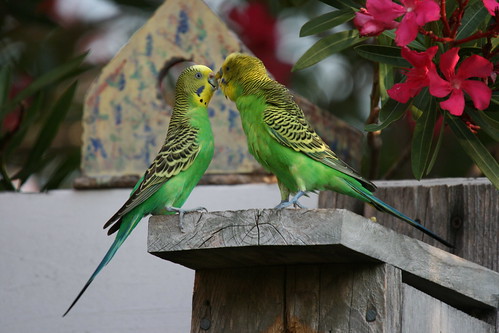Bird Brains Suggest How Vocal Learning Evolved
 Tuesday, March 11, 2008 at 11:14
Tuesday, March 11, 2008 at 11:14  Budgies that live wild in Florida. Though they perch far apart on the avian family tree, birds with the ability to learn songs use similar brain structures to sing their tunes. Neurobiologists at Duke University Medical Center now have an explanation for this puzzling likeness.
Budgies that live wild in Florida. Though they perch far apart on the avian family tree, birds with the ability to learn songs use similar brain structures to sing their tunes. Neurobiologists at Duke University Medical Center now have an explanation for this puzzling likeness.
In all three groups of birds with vocal learning abilities - songbirds, parrots and hummingbirds - the brain structures for singing and learning to sing are embedded in areas controlling movement, the researchers discovered. The team also found that areas in charge of movement share many functional similarities with the brain areas for singing. This suggests that the brain pathways used for vocal learning evolved out of the brain pathways used for motor control.
These ancient pathways, which power limb and body movements, constrained both the location and circuitry of structures for learning and imitating sounds, theorizes senior author Erich Jarvis, Ph.D., associate professor of neurobiology. The findings may also help solve the riddle of why humans talk with our hands and voice, but chimps can talk only with their hands.
"In its most specialized way, spoken language is the ability to control the learned movements of our larynx," Jarvis said. "It's possible that human language pathways have also evolved in ways similar to these birds. Perhaps the evolution of vocal learning brain areas for birds and humans exploited a universal motor system that predates the split from the common ancestor of birds and mammals."
The results appear in the March 12, 2008 edition of the journal PLoS ONE. The research was funded by the National Science Foundation and a National Institutes of Health Pioneer Award to Jarvis. The collaborative study was co-led by Henrik Mouritsen of the University of Oldenburg in Germany, who was supported by the VolkswagenStiftung, and first author Gesa Feenders, now a postdoctoral researcher at the University of Newcastle, UK.
"This innovative research exemplifies the bold thinking and creative approaches fostered by the NIH Director's Pioneer Award," said National Institutes of Health Director Elias A. Zerhouni, M.D. "The discovery that vocal learning brain pathways are embedded in the parts of the brain that control body movement offers unexpected insights on the origins of spoken language and could open up new approaches to understanding vocalization disorders in humans."
Jarvis and his colleagues examined bird species with vocal learning skills and some without: garden warblers, zebra finches, budgerigars (parrots), Anna's hummingbirds and ring doves. Their technique involved observing and manipulating bird behavior, then recording which genes were active in the birds' brains when the birds were moving and singing in certain ways.
"When we use this behavioral molecular mapping approach, we get gene expression patterns in the brain that light up like MRI images," Jarvis said. The study is the first to map the parts of the forebrain that control movement in birds. The forebrain is the largest part of the brain, and includes the pathways for thought, learning and perception.
While all birds vocalize, for most of them these sounds are genetically hardwired. Only songbirds, parrots and hummingbirds have the ability to learn songs. This type of vocal learning is similar to the way that humans learn to speak, Jarvis said.
"Based on the data, we think that the brain has a pre-existing substrate, namely a forebrain motor pathway, that led to the evolution of similar vocal learning pathways in three different bird families," Jarvis said.
The connection between movement and vocal learning also extends to humans, Jarvis suggests. Human brain structures for speech also lie adjacent to, and even within, areas that control movement. "We can make a plausible argument that in humans, our spoken language areas also evolved out of pre-existing motor pathways," he said. These pathways, he believes, date back to the common ancestor of reptiles, birds and mammals, creatures called stem amniotes that lived about 300 million years ago.
The results from birds are consistent with the hypothesis that spoken language was preceded by gestural language, or communication based on movements (one of several competing explanations for the origin of spoken language), Jarvis adds. Both humans and chimps gesture with the limbs while communicating, and young children gesture even before they begin talking. "Gesturing is something that goes along naturally with speech. The brain areas used for gesturing may have been co-opted and used for speech," Jarvis said.
Co-authors on the study include Miriam Liedvogel, University of Oxford, UK; Manuela Zapka, University of Oldenburg, Germany; Miriam Rivas, Haruhito Horita and Erina Hara, Duke; and Kazuhira Wada, Hokkaido University, Japan.
 Melopsittacus undulatus - Budgerigar | in
Melopsittacus undulatus - Budgerigar | in  Research,
Research,  Vocal learning
Vocal learning 
